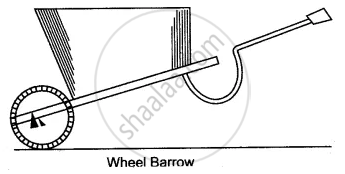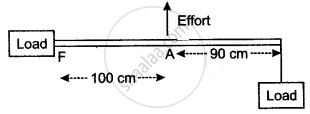Advertisements
Advertisements
Question
Fig 3.17 below shows a lever in use.

(a) To which class of lever does it belong?
(b) If FA = 80 cm, AB = 20 cm, find its mechanical advantage.
(c) Calculate the value of E.
Solution
(a) This is a class II lever.
(b) Given: FA=80 cm, AB = 20 cm, BF= FA+AB=100cm
Mechanical advantage M.A = `"𝐵𝐹"/"𝐴𝐹"`= `100/80` = 1.25
(c) Effort (E) = `"𝐿𝑜𝑎𝑑 (𝐿)"/"𝑀.𝐴"` = `5 /1.25` = 4 𝐾𝑔𝑓
APPEARS IN
RELATED QUESTIONS
Which class of lever will always have MA > 1 and why?
Write down a relation expressing the mechanical advantage of a lever.
Give one example of a class I lever where mechanical advantage is more than one ?
shows a nut cracker name the class of lever ?
Define Lever
The following belong to which class of lever?
A see-saw
The following belong to which class of lever?
Fore-arm
Draw a labelled sketch of a second class lever. Give one example of such a lever.
In the following diagram of a wheelbarrow, mark the fulcrum (F) and indicate the directions of load (L) and effort (E) with arrows.

What class of lever is it? Give one more example of the same class of lever.
The diagram shows the use of a lever.

- State the principle of moments as applied to the above lever.
- Which class of lever is this? Give an example of this class of lever.
- If FA = 100 cm, AB = 90 cm, calculate the minimum effort required to lift the load.
